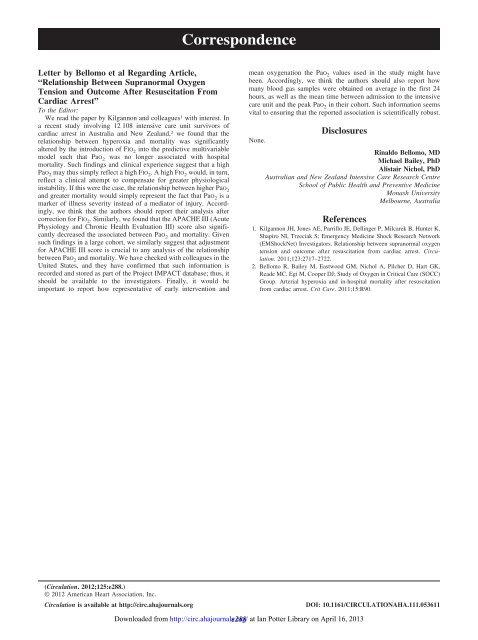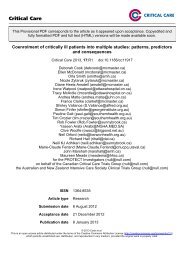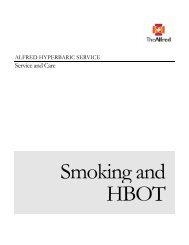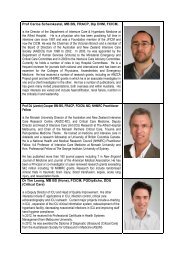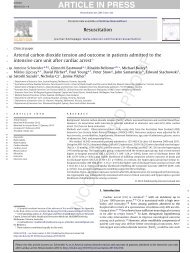See Full Article - Alfred Intensive Care Unit
See Full Article - Alfred Intensive Care Unit
See Full Article - Alfred Intensive Care Unit
- No tags were found...
You also want an ePaper? Increase the reach of your titles
YUMPU automatically turns print PDFs into web optimized ePapers that Google loves.
Correspondence<br />
Letter by Bellomo et al Regarding <strong>Article</strong>,<br />
“Relationship Between Supranormal Oxygen<br />
Tension and Outcome After Resuscitation From<br />
Cardiac Arrest”<br />
To the Editor:<br />
We read the paper by Kilgannon and colleagues 1 with interest. In<br />
a recent study involving 12 108 intensive care unit survivors of<br />
cardiac arrest in Australia and New Zealand, 2 we found that the<br />
relationship between hyperoxia and mortality was significantly<br />
altered by the introduction of FIO 2 into the predictive multivariable<br />
model such that PaO 2 was no longer associated with hospital<br />
mortality. Such findings and clinical experience suggest that a high<br />
PaO 2 may thus simply reflect a high FIO 2 . A high FIO 2 would, in turn,<br />
reflect a clinical attempt to compensate for greater physiological<br />
instability. If this were the case, the relationship between higher PaO 2<br />
and greater mortality would simply represent the fact that PaO 2 is a<br />
marker of illness severity instead of a mediator of injury. Accordingly,<br />
we think that the authors should report their analysis after<br />
correction for FIO 2 . Similarly, we found that the APACHE III (Acute<br />
Physiology and Chronic Health Evaluation III) score also significantly<br />
decreased the associated between PaO 2 and mortality. Given<br />
such findings in a large cohort, we similarly suggest that adjustment<br />
for APACHE III score is crucial to any analysis of the relationship<br />
between PaO 2 and mortality. We have checked with colleagues in the<br />
<strong>Unit</strong>ed States, and they have confirmed that such information is<br />
recorded and stored as part of the Project IMPACT database; thus, it<br />
should be available to the investigators. Finally, it would be<br />
important to report how representative of early intervention and<br />
mean oxygenation the PaO 2 values used in the study might have<br />
been. Accordingly, we think the authors should also report how<br />
many blood gas samples were obtained on average in the first 24<br />
hours, as well as the mean time between admission to the intensive<br />
care unit and the peak PaO 2 in their cohort. Such information seems<br />
vital to ensuring that the reported association is scientifically robust.<br />
None.<br />
Disclosures<br />
Rinaldo Bellomo, MD<br />
Michael Bailey, PhD<br />
Alistair Nichol, PhD<br />
Australian and New Zealand <strong>Intensive</strong> <strong>Care</strong> Research Centre<br />
School of Public Health and Preventive Medicine<br />
Monash University<br />
Melbourne, Australia<br />
References<br />
1. Kilgannon JH, Jones AE, Parrillo JE, Dellinger P, Milcarek B, Hunter K,<br />
Shapiro NI, Trzeciak S; Emergency Medicine Shock Research Network<br />
(EMShockNet) Investigators. Relationship between supranormal oxygen<br />
tension and outcome after resuscitation from cardiac arrest. Circulation.<br />
2011;123:2717–2722.<br />
2. Bellomo R, Bailey M, Eastwood GM, Nichol A, Pilcher D, Hart GK,<br />
Reade MC, Egi M, Cooper DJ; Study of Oxygen in Critical <strong>Care</strong> (SOCC)<br />
Group. Arterial hyperoxia and in-hospital mortality after resuscitation<br />
from cardiac arrest. Crit <strong>Care</strong>. 2011;15:R90.<br />
(Circulation. 2012;125:e288.)<br />
© 2012 American Heart Association, Inc.<br />
Circulation is available at http://circ.ahajournals.org<br />
DOI: 10.1161/CIRCULATIONAHA.111.053611<br />
Downloaded from http://circ.ahajournals.org/ e288 at Ian Potter Library on April 16, 2013


